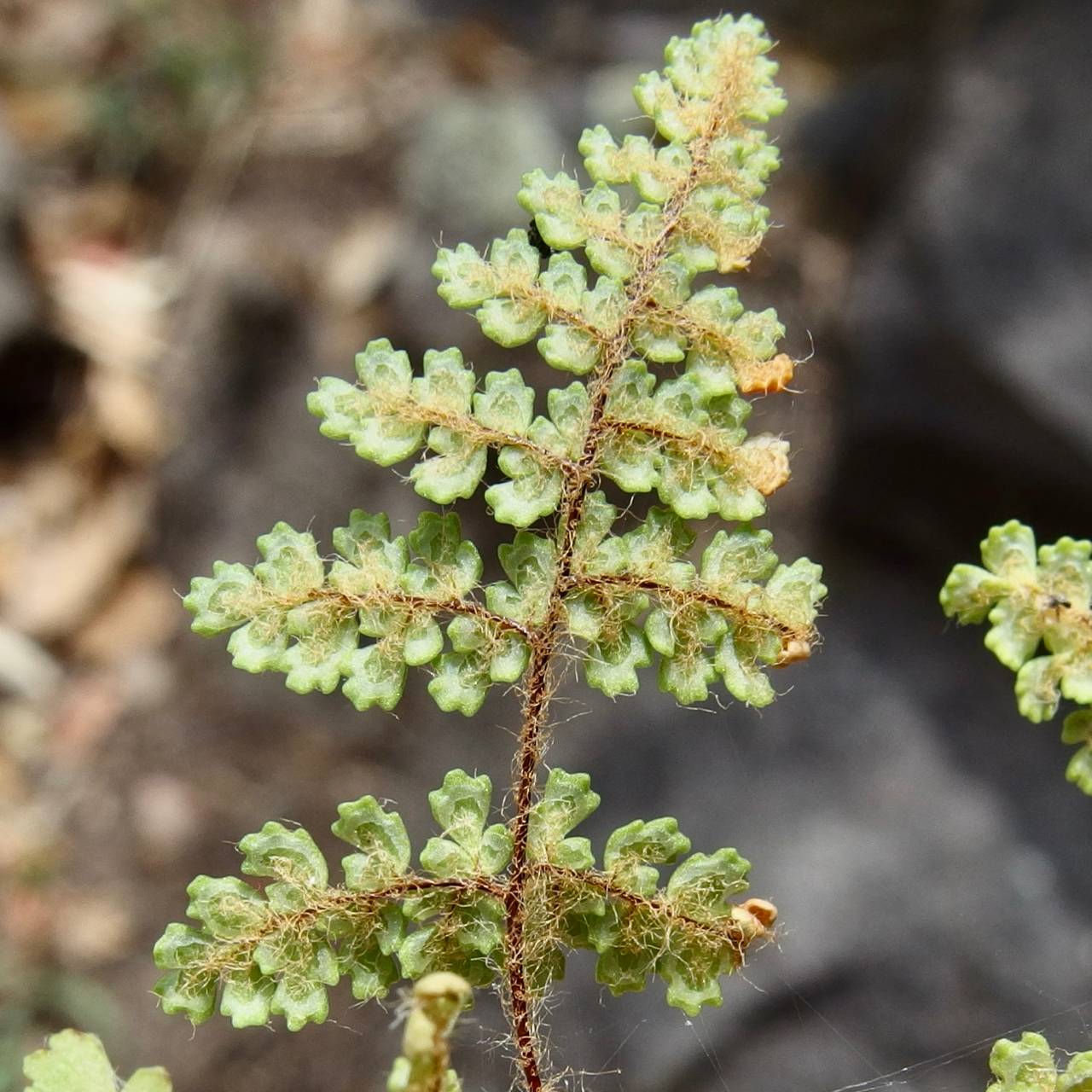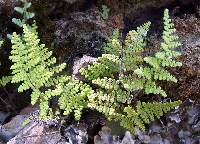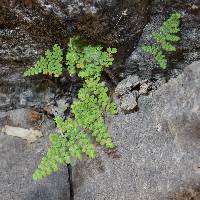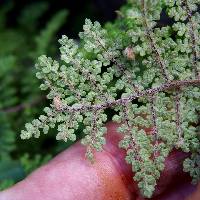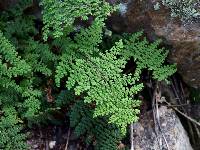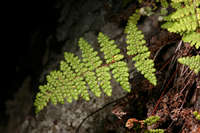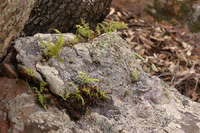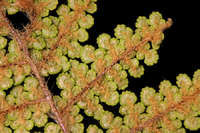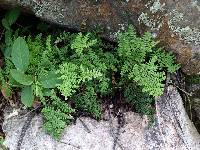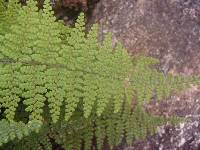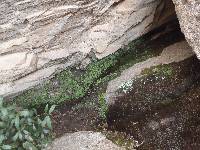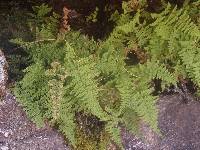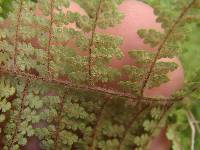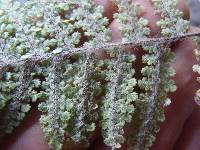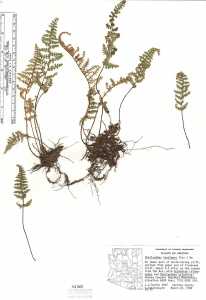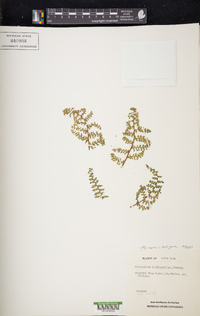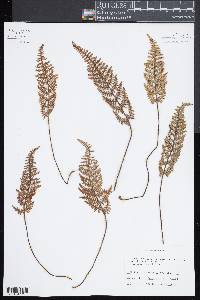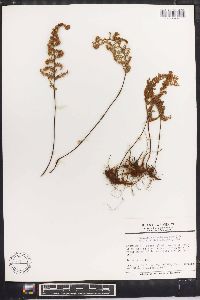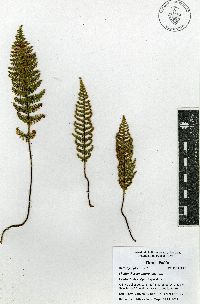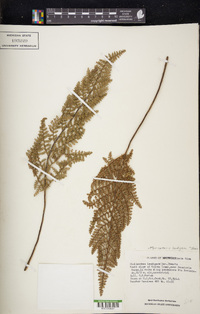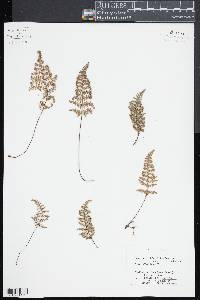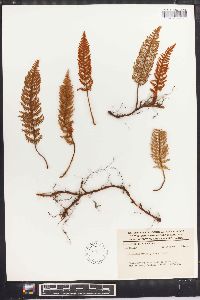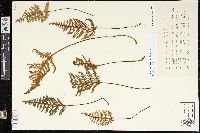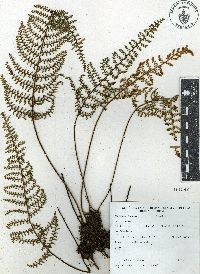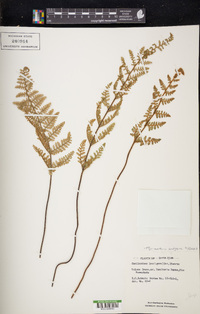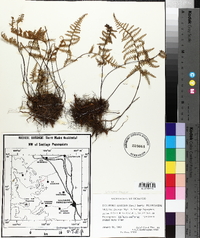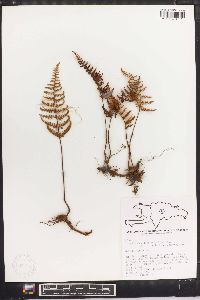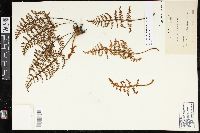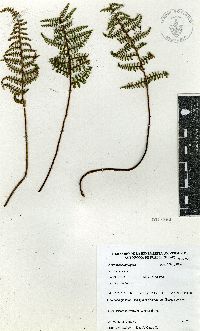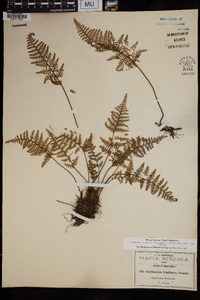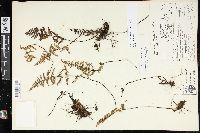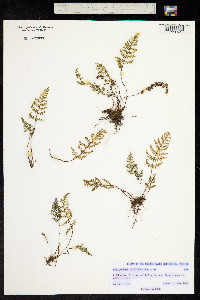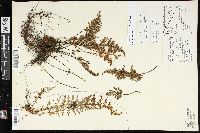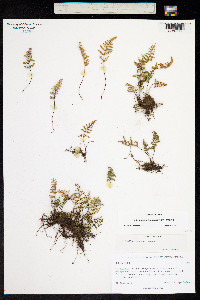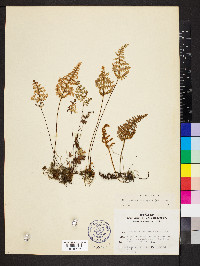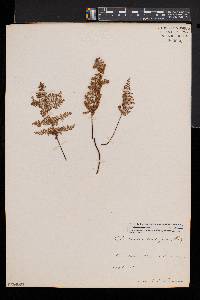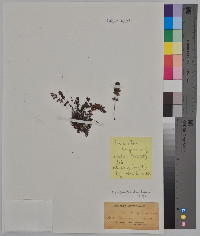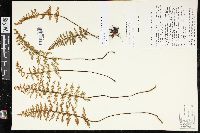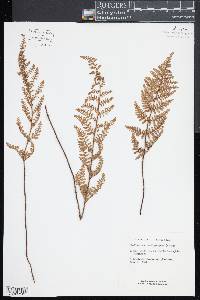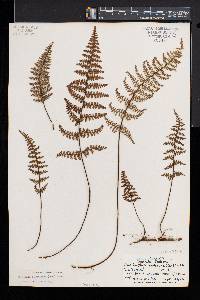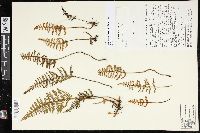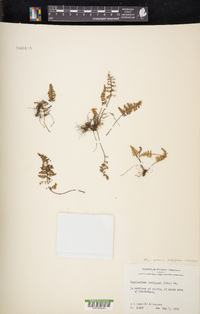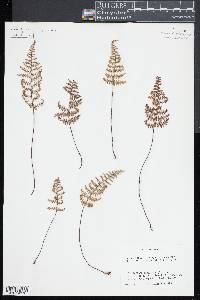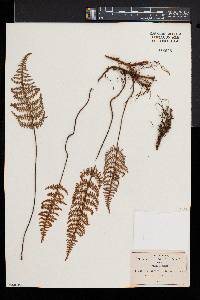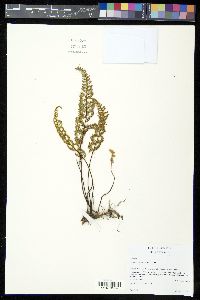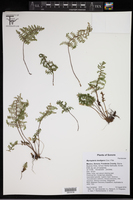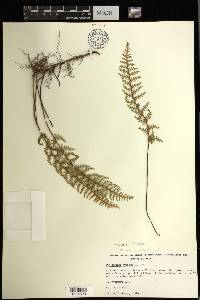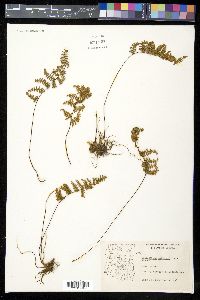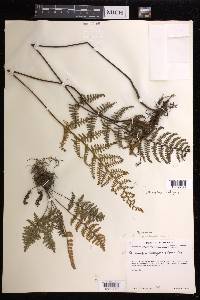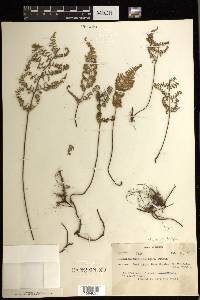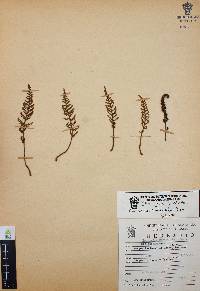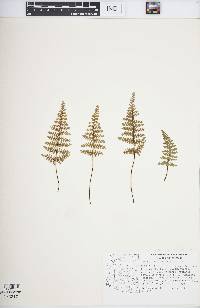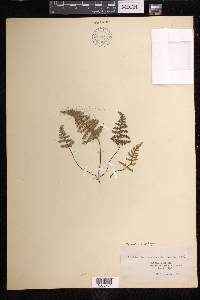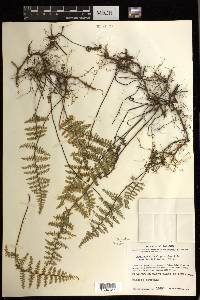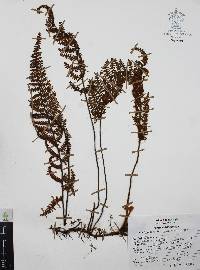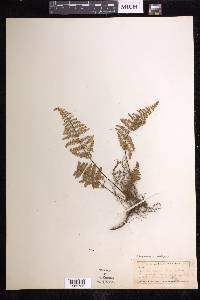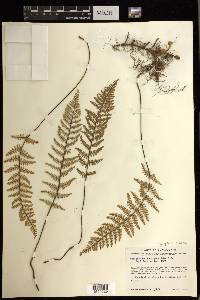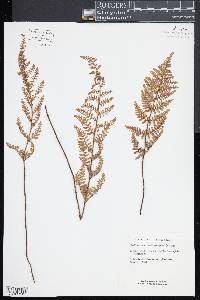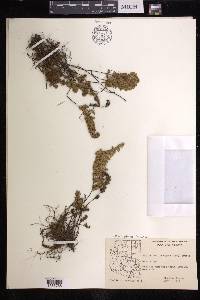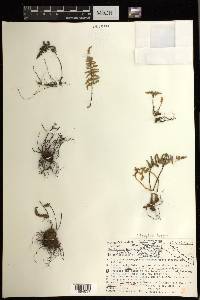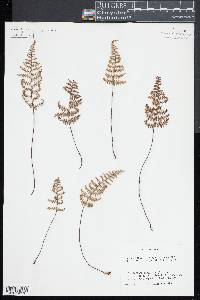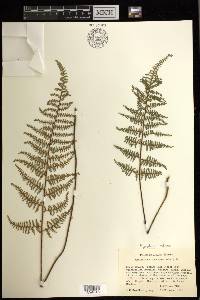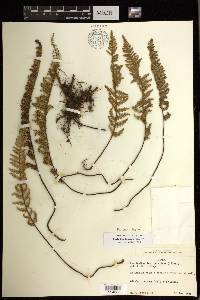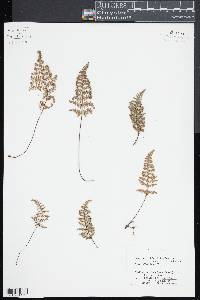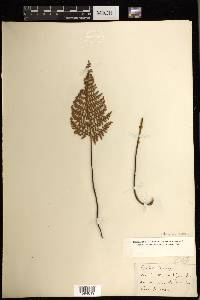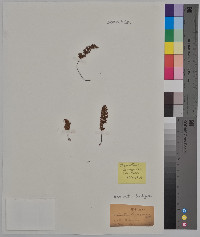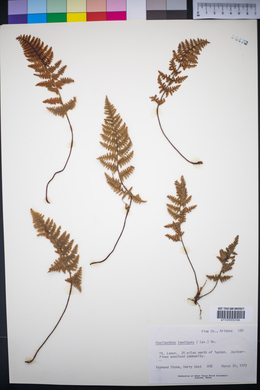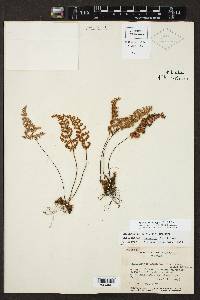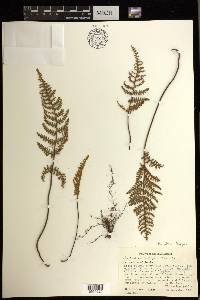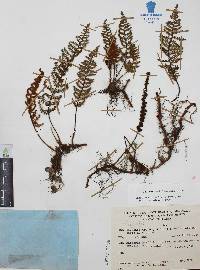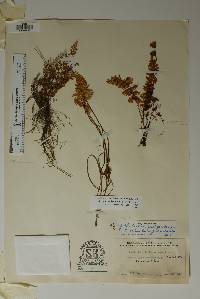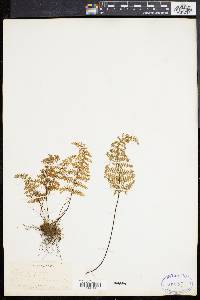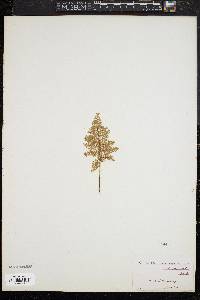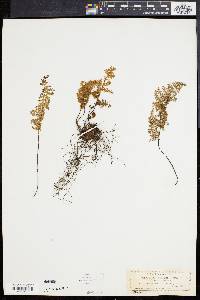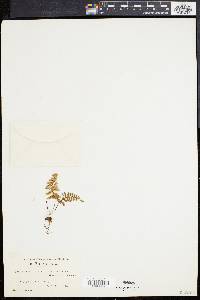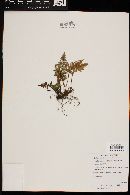Myriopteris lendigera
|
|
|
|
Family: Pteridaceae
Nit-Bearing Lip Fern, more...nitbearing lipfern
[Cheilanthes lendigera (Cav.) Sw., moreCheilanthes minor Mart. & Gal., Hemionitis lendigera (Cav.) Christenh., Pomataphytum pocillatum M.E.Jones] |
Stems long-creeping, 1--3 mm diam.; scales uniformly brown or with poorly defined, dark, central stripe, linear-lanceolate, straight to slightly contorted, loosely appressed, usually persistent. Leaves scattered to clustered, 5--30 cm; vernation noncircinate. Petiole usually dark brown, rounded adaxially. Blade ovate-deltate to oblong-lanceolate, usually 4-pinnate at base, 1.5--8 cm wide; rachis rounded adaxially, with scattered linear scales and dense monomorphic pubescence. Pinnae not articulate, dark color of stalk continuing into pinna base, basal pair not conspicuously larger than adjacent pair, usually equilateral, appearing glabrous or sparsely pubescent adaxially. Costae green adaxially for most of length; abaxial scales uniseriate and hairlike. Ultimate segments round to slightly oblong, beadlike, the largest 1--3 mm, abaxially sparsely to moderately pubescent with coarse hairs, adaxially glabrous. False indusia inframarginal, strongly differentiated, 0.25--0.5 mm wide, forming pouch with constricted aperture on abaxial surface of ultimate segments. Sori ± continuous around segment margins. 2 n = 120. Sporulating summer--fall. Rocky slopes and ledges, usually on igneous substrates; 1300--2400 m; Ariz., Tex.; Mexico; Central America; South America. Cheilanthes lendigera has the small, beadlike ultimate segments characteristic of subgenus Physapteris ; the prominent inframarginal false indusia and near absence of multiseriate costal scales serve to distinguish it from all other North American members of that group. T. Reeves (1979) suggested that C . lendigera is a fertile allotetraploid resulting from hybridization between the Mexican species Cheilanthes mexicana Davenport and C . marsupianthes (Fée) T. Reeves ex Windham (unpublished).
General: Loosely scattered to clustered, 5-30 cm tall, noncircinate vernation, from long-creeping stems, 1-3 mm in diameter, with uniformly brown scales or bearing a poorly defined central stripe, linear-lanceolate, loosely appressed and persistent. Leaves: On dark brown petiole, rounded above, blade ovate-deltate to oblong lanceolate, usually 4-pinnate at base, 1.5-8 cm wide; rachis rounded above, with scattered linear scales and dense pubescence; pinnate not articulate, equilateral, appearing glabrous or sparsely pubescent above, costae green for most of length, scales below arranged in a single row and hairlike, ultimate segments round to slightly oblong and beadlike, largest 1-3 mm; sparsely to moderately pubescent with coarse hairs below, glabrous above. Sporangia: False indusia below margin, strongly differentiated, 0.25-0.5 mm wide, forming pouch with constricted aperture on lower surfaces of ultimate segments, sori continuous around segment margins. Ecology: Found on rocky slopes and ledges, usually on igneous substrates from 5,000-8,000 ft (1524-2438 m); sporulates summer-fall. Notes: Distinctive with its 4-pinnate leaves, as well as the way the hairlike scales below are arranged along the rachis and stems in a single row. Etymology: Cheilanthes is from Greek cheilos for lip and anthos for flower, while lendigera is from the Latin word lendigerus, which is thought to be a derivative of the Latin lens, which was a word for lentil. Sources: FNA 1993 FNA 1993 Common Name: nitbearing lipfern Rarity: G5 General: Loosely scattered to clustered, 5-30 cm tall, noncircinate vernation, from long-creeping stems, 1-3 mm in diameter, with uniformly brown scales or bearing a poorly defined central stripe, linear-lanceolate, loosely appressed and persistent. Leaves: On dark brown petiole, rounded above, blade ovate-deltate to oblong lanceolate, usually 4-pinnate at base, 1.5-8 cm wide; rachis rounded above, with scattered linear scales and dense pubescence; pinnate not articulate, equilateral, appearing glabrous or sparsely pubescent above, costae green for most of length, scales below arranged in a single row and hairlike, ultimate segments round to slightly oblong and beadlike, largest 1-3 mm; sparsely to moderately pubescent with coarse hairs below, glabrous above. Sporangia: False indusia below margin, strongly differentiated, 0.25-0.5 mm wide, forming pouch with constricted aperture on lower surfaces of ultimate segments, sori continuous around segment margins. Ecology: Found on rocky slopes and ledges, usually on igneous substrates from 5,000-8,000 ft (1524-2438 m); sporulates summer-fall. Notes: Distinctive with its 4-pinnate leaves, as well as the way the hairlike scales below are arranged along the rachis and stems in a single row. Ethnobotany: Unknown Etymology: Cheilanthes is from Greek cheilos for lip and anthos for flower, while lendigera is from the Latin word lendigerus, which is thought to be a derivative of the Latin lens, which was a word for lentil. Synonyms: None Editor: SBuckley, 2010 |
|
|
|

